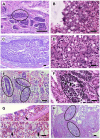Development of a qPCR molecular diagnostic assay for the detection of kiwi Eimeria species and its application to determine tissue-specificity of species causing coccidiosis in North Island brown kiwi (Apteryx mantelli)
- PMID: 40610817
- PMCID: PMC12226697
- DOI: 10.1007/s00436-025-08521-0
Development of a qPCR molecular diagnostic assay for the detection of kiwi Eimeria species and its application to determine tissue-specificity of species causing coccidiosis in North Island brown kiwi (Apteryx mantelli)
Abstract
Juvenile kiwi (Apteryx spp.) within captive-rearing programmes commonly suffer from coccidiosis, which primarily affects the intestine but can also impact other organs, such as the kidneys, liver, lung, and spleen (Morgan et al. Avian Pathol 42:137-146 2013). In some immune-compromised birds, disease causes significant morbidity and, occasionally, mortality (Morgan et al. NZVJ 62:315-320 2014); however, understanding of the biology of disease-causing Eimeria species in kiwi is limited. A probe-based qPCR assay targeting a 115-bp fragment of the Eimeria mitochondrial cytochrome c oxidase I (CO1) gene was developed to identify three distinct kiwi Eimeria species: the two species most commonly recovered from faeces, Eimeria kiwii and Eimeria apteryxii, as well as the newly described species, Eimeria koka (Scheltema et al. Syst Parasitol 102:30 2025). The qPCR assay was then applied to retrospectively analyse formalin-fixed paraffin-embedded intestine, kidney, liver, lung, and spleen tissues from ten historic post-mortem cases from kiwi diagnosed with extraintestinal coccidiosis. This novel assay detected infection more often (33/47 tissues) than manual histopathological identification (25/47 tissues). Only one species, E. koka, was detected in extraintestinal tissues with the highest prevalence (9/10) in kidney tissues. In contrast, E. kiwii was reliably detected in 8/9 intestinal tissues but was not detected in the other tissues tested. E. apteryxii was not detected in any of the tissues analysed. These findings suggest that kiwi are infected by at least one intestinal and one renal-specific species, the latter of which is suspected to disseminate under certain conditions to other organs of the body.
Keywords: Eimeria; CO1; Coccidiosis; Extraintestinal infection; qPCR.
© 2025. The Author(s).
Conflict of interest statement
Declarations. Ethics approval: Animal ethics approval was not required for this study as DNA was extracted from post-mortem samples from an existing collection and analysed retrospectively, and faecal samples submitted as part of routine diagnostic testing. Consent to participate: Not applicable. Consent for publication: Not applicable. Competing interests: The authors declare no competing interests.
Figures



References
-
- Bassett S (2012) Operation nest egg incubation and chick rearing best practice protocols. Oralis Limited, Wellington, N.Z.
-
- Ball SJ, Pittilo RM, Long PL (1989) Intestinal and extraintestinal life cycles of eimeriid coccidia. In: Baker JR, Muller R (eds) Advances in parasitology, vol 28. Academic Press, pp 1–54. 10.1016/S0065-308X(08)60330-9 - PubMed
-
- Brunnert SR, Altman NH (1992) Hepatic coccidiosis in chamois (Rupicapra rupicapra). J Zoo Wildl Med 23:276–280
-
- Chappell LH (1969) Competitive exclusion between two intestinal parasites of the three-spined stickleback, Gasterosteus aculeatus L. J Parasitol 55:775. 10.2307/3277217
Publication types
MeSH terms
Substances
LinkOut - more resources
Full Text Sources
Miscellaneous

